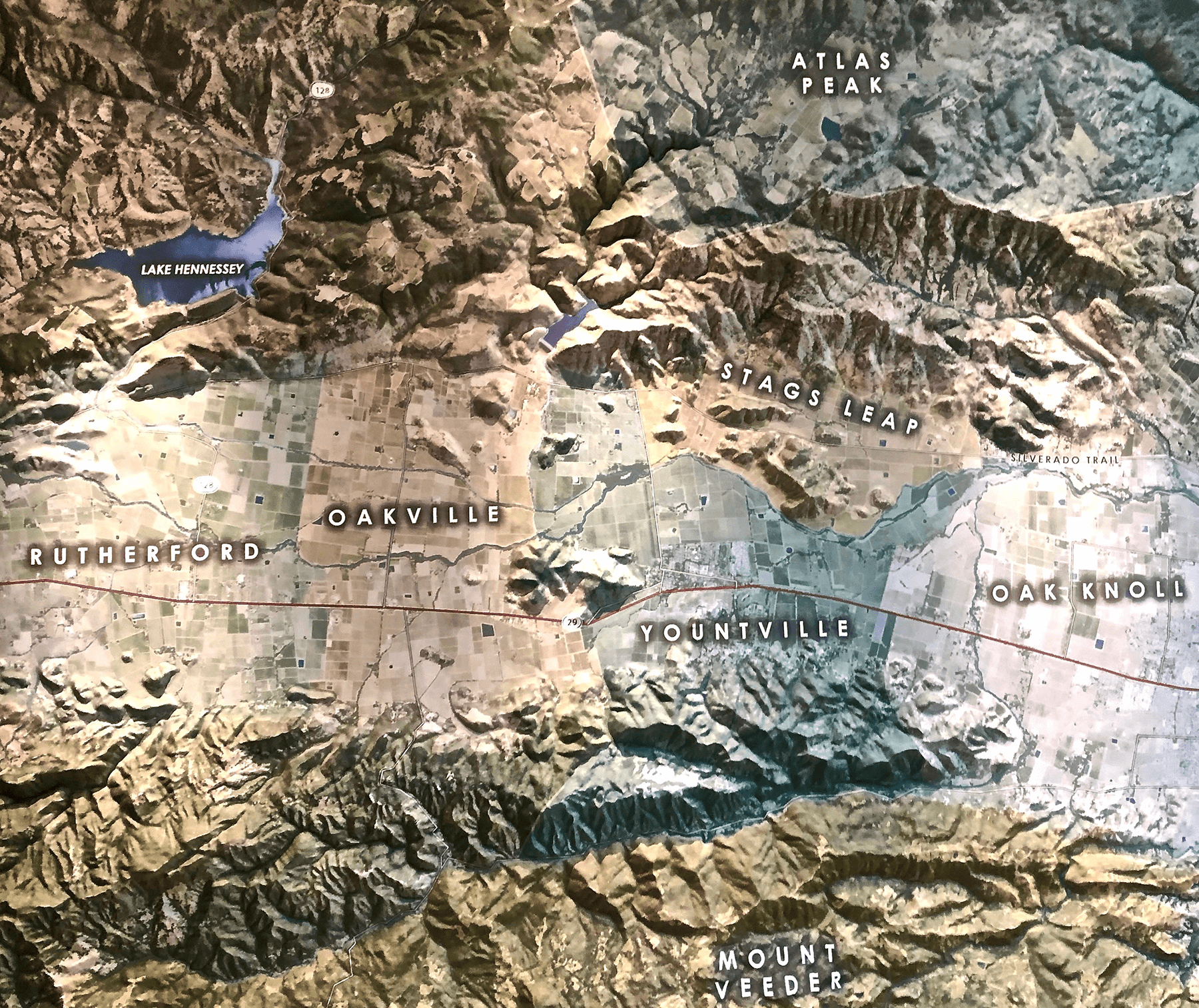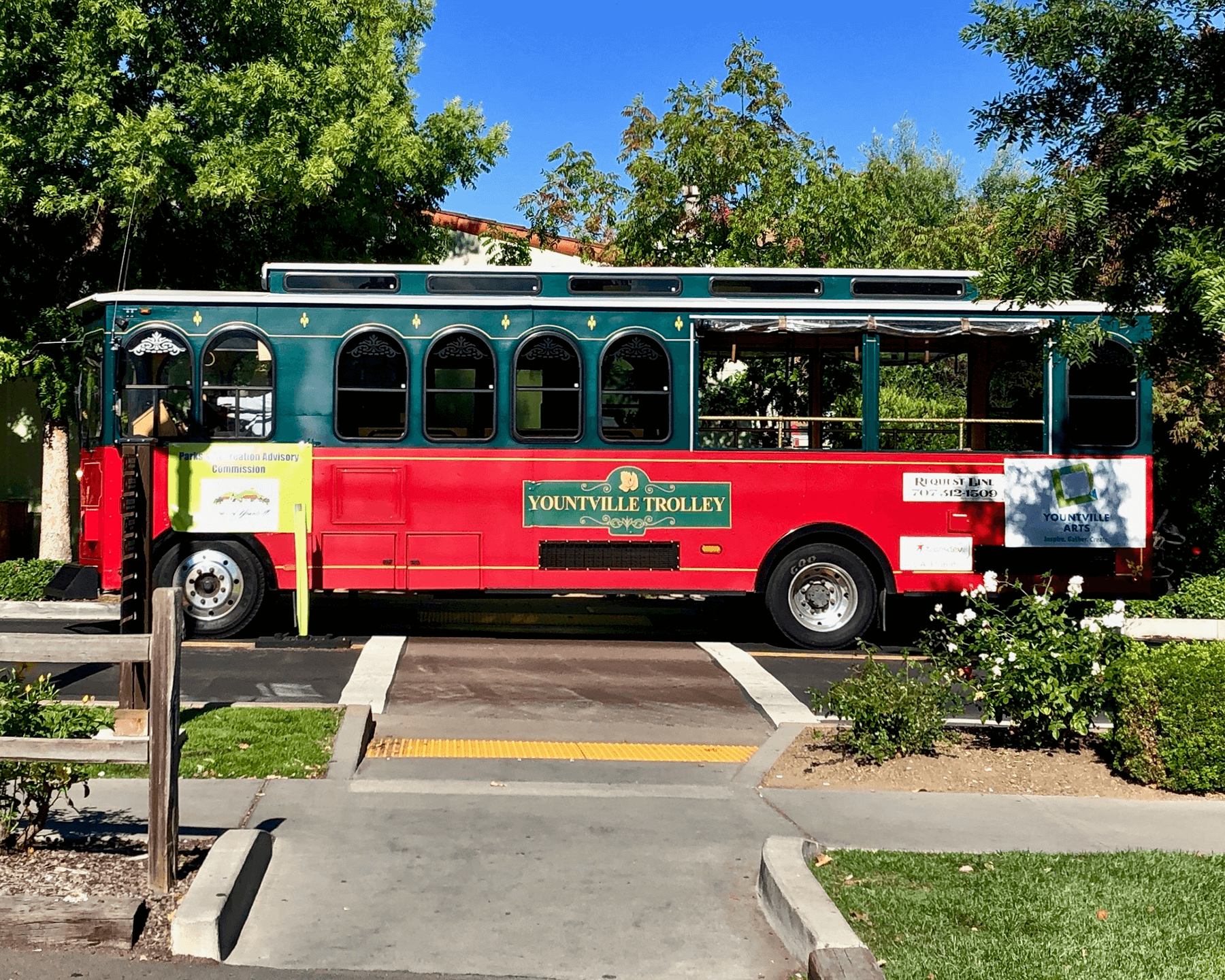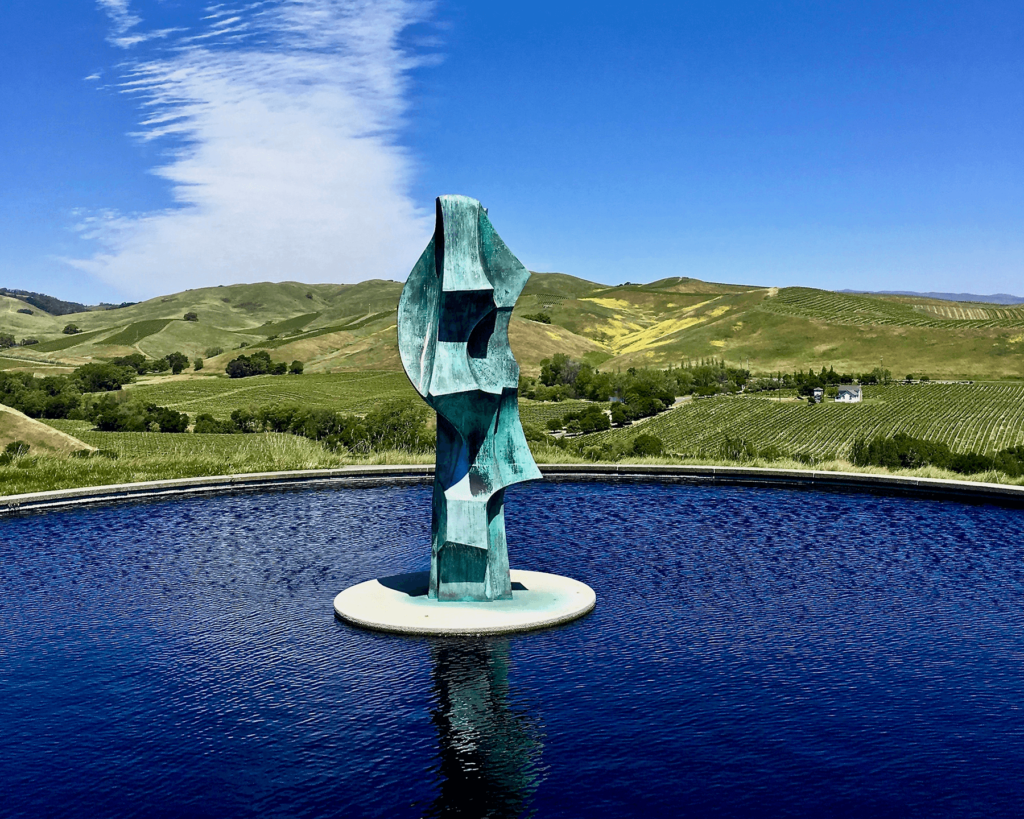Tips and advice for a successful Napa Valley trip.
There’s no place quite in the world like the Napa Valley. Superbly crafted wines, breathtaking scenery, and luxurious lodgings, spas, and restaurants can, of course, be found elsewhere. But no other grape-growing region assembles the package with the same flair—dare we say savoir faire?—as the valley.
Itineraries
Downtown Napa in a Day
48 Perfect Hours in Calistoga
3 Historic Napa Valley Wineries Day Trip
3 St. Helena Wineries with a Personal Touch
10 Foolproof Napa Valley Cabernet Tasting Experiences
2 Splendid Days in Walkable Yountville
What’s Where
The oft-Instagrammed 3-D topographical map in the Archer Hotel Napa’s lobby (three details on this page) shows the Napa Valley’s 16 subappellations, or American Viticultural Areas, each AVA (for short) having earned distinction for its soils, elevation, microclimate, or a combination of these. Among the recognizable AVAs—all known for Cabernet Sauvignon, though other grapes are grown—are Atlas Peak, Howell Mountain, Oakville, Rutherford, and Spring Mountain. The valley’s prestigious producers present their world-class vintages in six towns, from Napa in the south to Calistoga in the north:

Napa
Napa is the name of a county, the famous valley (which makes up much of the county) and, the county’s largest city. With a population of about 80,000, Napa is the valley’s most visited town, though this is a relatively recent development. Downtown Napa’s renaissance, jump-started by the 2001 opening of the Copia food, wine, and cultural center, continued unabated even after the center’s demise in 2008. Things came full circle when the Culinary Institute of America reopened the center as CIA at Copia, offering daily cooking classes and demonstrations. There’s also an open-kitchen restaurant and, just outside, a patio amid a small olive grove.
Near Copia is the Oxbow Public Market, a foodies’ mecca for its artisanal foods, wines, and spirits that derives its name from the shape of the nearby bend in the Napa River. The town, which sprawls in all directions from downtown, includes urban- and rustic-chic lodgings, from owner-run inns to full-scale resorts. The downtown dining scene has evolved into one of the county’s finest. West and southwest of downtown Napa lies the Napa County portion of the Carneros subappellation (the other half is in Sonoma County). You’ll find the most Pinot Noir in the valley at Carneros District wineries.
Yountville
For a town of about 3,000 people, a third of whom live in one of the country’s most favorably situated veterans homes, Yountville has an outsize reputation for culinary excellence. Several restaurants, a champagne-and-caviar salon, a bakery, and a fancy culinary shop owned by star chef Thomas Keller do business downtown. Michael Chiarello and other notable chefs have also established themselves here. Though it technically is located in Napa, Cindy Pawlcyn’s landmark Mustards Grill, falls within Yountville’s orbit, too. Lodgings range from fancy small inns to swank contemporary hotels and resorts, all priced accordingly. If fine dining is a focus of your visit, Yountville is an excellent place to base yourself. You can walk from many hotels – the Yountville Lodgings Cheat Sheet has recommendations – to downtown restaurants, or get a lift from the free Yountville Trolley. See the 2 Splendid Days in Walkable Yountville itinerary for suggestions about what to do when you’re in town.

Oakville and Rutherford
With a population of a mere few hundred between them, Oakville and Rutherford are all about farming, specifically Cabernet Sauvignon that goes into the wines of Robert Mondavi, Silver Oak, Inglenook, Caymus, Far Niente, and other storied brands. Many local winemakers turn up at the Rutherford Grill, one of a handful of restaurants in its namesake town. The Oakville Grocery, established in 1881 and these days a purveyor of upscale ingredients and prepared food, feeds the most people, albeit in large numbers tourists, in its town.
St. Helena
St. Helena, population about 6,200, is the valley’s genteel darling. Like the city of Napa, St. Helena sprawls for miles and contains more than 100 wineries and many noteworthy restaurants. Its Main Street downtown evokes the late 19th century, when Charles Krug, which bills itself as the valley’s oldest operating winery, was in its first heyday. Run these days by the family of the late Peter Mondavi Sr., Krug vaulted itself into the 21st century with a spectacular renovation. The firm of Howard Backen, one of the Northern California wine country’s most celebrated architects, masterminded the Charles Krug transformation.

Beringer, HALL St. Helena, and Joseph Phelps join Charles Krug among the many high-profile wineries in St. Helena. These wineries are easily accessed from lodgings that include the roadside El Bonita Motel and the deluxe Meadowood Napa Valley Resort. The 68-room Alila Napa Valley resort provides (adult-only, per its website) lavish comfort, too. Numerous small to midsize inns are also in the mix. The St. Helena Lodgings Cheat Sheet briefly describes the best options.
Until it perished in the 2020 Glass Fire, The Restaurant at Meadowood was the town’s marquee dining spot, but St. Helena does down-home and downscale very well, too. Try the Clif Family Bruschetteria Food Truck or the perennially popular Gott’s Roadside for plush burgers and 21st-century comfort food. Check out the full-day itinerary 3 St. Helena Wineries with a Personal Touch for a surefire good time.
Calistoga
Sam Brannan, who made a fortune selling shovels and other equipment to miners during California’s gold rush, established Calistoga, population 5,500, as a spa town in the 19th century. He lost his fortune in the process, but were he to rematerialize today he’d feel right at home: the formerly sleepy town he founded has become a haven of spas and luxury resorts. Places like Solage transformed the age-old ritual of mud bath, steam, mineral bath, and massage with new and less gloopy regimens. To be sure, though, the heritage treatments still have their adherents.
There are fewer destination restaurants in Calistoga than in St. Helena, Yountville, or Napa, but Solbar, Evangeline, and a few others have attracted notice. The Calistoga Restaurants Cheat Sheet describes the best options in a nutshell. Calistoga rivals Napa for budget accommodations, and there are numerous owner-run inns. The Calistoga Lodging Cheat Sheet will help you narrow your search.
Summer days are hotter in Calistoga than almost everywhere else in the valley. The temperature is perfect for Cabernet Sauvignon, which dominates production here, along with Petite Sirah and other heat-seeking varietals. The 48 Perfect Hours in Calistoga itinerary has suggestions about which wineries to visit.

Year-round Destination
The Napa Valley is a year-round destination. Northern California residents and people visiting the San Francisco Bay Area frequently make day trips and weekend excursions for wine-tasting and other activities, but to get to know the valley, plan on spending at least three or four days. In that space of time you can check out some wineries, get pampered at a spa, visit a few top restaurants, and perhaps take a balloon ride above the vineyards or a bicycle ride past them.
The Napa Valley is at its busiest between May and late October, with flurries of activity at other times during Christmas holidays and the many festivals that take place. Even during high season, though, all but the most popular places are uncrowded during the week.
The Napa Valley has a mild climate, though the weather varies from place to place. It’s generally warmer in the northern part of the valley and on the valley floor, and cooler in the southern section and on the hillsides. During the day, temperatures are usually between 60°F and 70°F in spring and late fall and 80°F and 90°F during the summer and early fall, with some days as high as 100°F or more. During the day in winter temperatures are usually between 58°F and 65°F. In summer, some parts of the valley can be foggy as the day begins, but the fog usually burns off well before noon.
In nondrought years, the rainy season starts in November, with the heaviest precipitation often from December through February. From May to October it rains infrequently, sometimes not at all.
Clothing
Casual clothes are the Napa Valley norm, though you won’t feel out of place anywhere if you dress up a little, and at fancier wineries, restaurants, and lodgings you’ll fit in better. Even in the summer it’s wise to pack a sweater or light jacket, which can come in handy when the evening marine breezes, so good for the grapes, often cool the valley considerably. Women may find themselves more comfortable in flats or low heels, especially when going on winery or vineyard tours or standing at tasting bars. From spring through harvest can be very sunny: pack a sunhat or visor, sunglasses, and sunblock. From November through April you may need an umbrella.

How to Get Here and Get Around
By Air
The San Francisco and Oakland airports are the key gateways to the Napa Valley, but depending where you’re coming from, which airlines you prefer flying, and where you’re staying, the airports in Sacramento and Santa Rosa can be convenient options, too.
For many visitors, a trip to the Napa Valley is part of a longer stay in San Francisco or elsewhere in the Bay Area—the part for which they rent a car—and of course it’s a favorite day trip by car for many locals. You can also get to Napa County from San Francisco and the East Bay (Oakland, Berkeley, and other towns across the San Francisco Bay from San Francisco) by a combination of a ferry or commuter train and a bus.
San Francisco International Airport (SFO), served by many carriers, is about 66 miles south of Santa Rosa and 82 miles south of Healdsburg off U.S. 101; the airport is 58 miles south of the town of Sonoma (reached by heading east on Highway 37 and north on Highway 121 to Highway 12 also north. In normal traffic, including on surface streets in San Francisco, it takes 90 minutes to drive from the airport to Santa Rosa, 100 minutes to Healdsburg, and 75 or 80 minutes to Sonoma.
Oakland International Airport (OAK), served by many carriers, is about 58 miles southeast of the middle of the town of Sonoma via interstate highways 880 and 580, the Richmond–San Rafael Bridge, U.S. 101, and state highways 37, 121, and 12. To get to Santa Rosa, which is 67 miles from the airport, and Healdsburg, which is 83 miles north, stay on U.S. 101. The drive to Sonoma takes about 80 minutes, Santa Rosa about 90 minutes, and Healdsburg about 100 minutes.
Charles M. Schulz – Sonoma County Airport (STS), in Santa Rosa about 2 miles west of U.S. 101 and 8 miles northwest of downtown Santa Rosa, is served by Alaska, American, Sun Country, and United Express. Some flights are seasonal. Among the reasons to consider flying here: arriving and renting a car is a breeze, as is going through security on the way home, and on Alaska you can check up to a case of wine for free. Except for a few western U.S. cities, ticket prices tend to be higher here than to SFO or OAK, but it’s worth comparing prices even from farther afield.
Sacramento International Airport (SMF), served by several major airlines, is about 90 miles east of Calistoga. It’s arguably as convenient as SFO or OAK for visitors staying in St. Helena or Calistoga, and not bad for those staying in the southern Napa Valley, too.
Transfers
Car and ride hailing: Uber, Lyft and other ride-hailing services operate out of all the airports. Zipcar vehicles can be picked up at SFO, OAK, and SMF.
Private Limos: Pure Luxury Transportation provides car and SUV service from SFO, OAK, and SMF. Perata Luxury Car Services provides similar service from those airports and STS.
Public transit: Though few travelers take this option, and it’s really only feasible if you’re traveling light, it is possible to get from SFO or OAK to the Napa Valley on public transit, and you could save the cost of a high-quality bottle of Napa Valley Cabernet Sauvignon (each way) compared to some of the other options. If you make all the connections without a hitch, it will take from 2.5 to 3 hours.
Directions: From SFO or OAK, take a BART commuter train to El Cerrito Del Norte station in the East Bay. From there you can board (on weekdays only) a VINE express bus that makes stops between Napa and Calistoga or (daily) a regular VINE bus to the Soscol Gateway Transit Center in downtown Napa. At the transit center you can switch to a VINE local bus or call a cab or a ride-hailing service.
By Car
The Napa Valley can be reached by car via several routes.
From San Francisco or Oakland: Travel east on Interstate 80 over the San Francisco–Oakland Bay Bridge, continuing north on the interstate to Highway 37, on which you’ll head west to Highway 29 north to the city of Napa.
From San Francisco: Alternatively, you can head north from San Francisco on U.S. 101 across the Golden Gate Bridge, heading east on Highway 37 and Highway 121 to Highway 29 north.
From Santa Rosa: Exit U.S. 101 at Mark Springs West Road and head east, continuing east when the road’s name changes to Porter Creek Road and turning east (left) onto Petrified Forest Road. The road dead-ends at Foothill Rd.; head south from here to Highway 29, heading east to get to Calistoga’s main drag (Lincoln Avenue) and south to get to St. Helena and other Napa Valley towns.
From Sonoma (city): Head south on Highway 12 and west on Highway 121 to Highway 29 north to the city of Napa.
From Sacramento: From the airport, take Interstate 5 north to Interstate 505 south to Highway 128 west. At the Silverado Trail, head north for St. Helena and Calistoga, and south for Yountville and Napa.
Driving the Napa Valley
Driving a car is by far the most efficient way to explore the Napa Valley—according to a recent study, 94% of all visitors experience the valley this way.
The Napa Valley angles northwest from Napa in the south to Calistoga in the north. To keep your bearings straight, it’s good to memorize the names and locations of the six major towns. From south to north they are: Napa, Yountville, Oakville, Rutherford, St. Helena, and Calistoga. All but Napa are subappellations of the Napa Valley American Viticultural Area (AVA), so in addition to highway signs, you’ll also see signs indicating this.
No more than 5 miles wide at any point, the valley, about 30 miles long, is served by two primary north–south roads, Highway 29 and, to the east, the Silverado Trail. Several east–west roads, including Oak Knoll Avenue, the Oakville Cross Road, and Deer Park Road, connect Highway 29 and the Silverado Trail.
Tips: The Silverado Trail is often quicker than Highway 29 when you’re traveling the length of the valley (i.e., between Napa and St. Helena or Calistoga). Even in the Wine Country there are traffic jams, as workers head home from the wineries and visitors head back to San Francisco. If you’ve not left the valley by 3 pm, expect to sit in traffic on Highway 29 and the Silverado Trail (though longer on 29), and on Highway 121 heading west toward Sonoma on the way to San Francisco.
Ride hailing: Uber and Lyft operate throughout the valley. Zipcar vehicles can be picked up at the Soscol Transit Center (see Transportation Hubs, below) and elsewhere.
By Commuter Train and Bus
From San Francisco or Oakland: Take a BART train to El Cerrito Del Norte station. On weekdays, board a VINE express bus with one or more stops in each town between Napa and Calistoga. Daily, regular VINE buses head to downtown Napa’s Soscol Gateway Transit Center, where you can switch to a local bus or call a cab or a ride-hailing service. The Yountville Trolley serves its town for free.
By Ferry and Bus
511 SF Bay provides comprehensive information about traffic and public transit throughout the Bay Area. On the organization’s website you can get real-time traffic reports and plan trips on public transportation.
Taking the San Francisco Bay Ferry from San Francisco to the town of Vallejo and then picking up a VINE bus to Napa is an attractive option. The ferry departs from the Ferry Building and Pier 41 in San Francisco. In Vallejo, take the bus from the dock to the Soscol Gateway Transit Center in Napa. The number of ferry departures varies depending on the time of year (there are more ferries from late spring to early fall), and buses occasionally substitute for ferries.
Though it’s not always practical time wise and isn’t convenient for visiting wineries along the Silverado Trail, you can get around the Napa Valley on VINE Bus 10, which travels from downtown Napa up Highway 29 to downtown Calistoga. Bus 10 and other VINE buses serve the city of Napa; the Yountville Trolley (707-944-1234; after 7 pm 707-312-1509) provides door-to-door service within Yountville; and the St. Helena (707-963-3007) and Calistoga (707-963-4229) shuttles (weekdays only) provide on-demand transit service, most of the time within 15 to 30 minutes of patrons’ calls.
Soscol Gateway Transit Center (625 Burnell St., at 4th St.), in downtown Napa, is the valley’s transportation hub. Many VINE bus routes depart from here, including Bus 10, which serves Napa, Yountville, Oakville, Rutherford, St. Helena, and Calistoga.
This story first appeared online in 2017; it was fact-checked and updated in 2022.

Pingback: 48 Perfect Hours in Calistoga – Daniel Mangin
Pingback: St. Clair Brown Winery & Brewery – Daniel Mangin
Pingback: Stag’s Leap Wine Cellars – Daniel Mangin